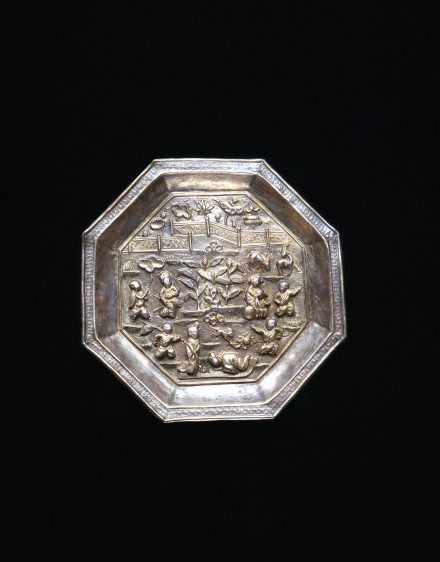J.J. Lally & Co., Oriental Art / New York City, New York
MenuPast Exhibition
Chinese Porcelain and Silver in the Song Dynasty
March 18 - April 8, 2002

31.
A PARCEL-GILT SILVER OCTAGONAL DISH
Song Dynasty, A.D. 13th Century
decorated in repoussé technique with an auspicious scene of boys at play in a garden, all in high relief on finely detailed grounds, with a pair of deer grazing in front of an elaborate balustrade enclosing a lotus pond at the top and with tall flowering plants and ornamental rocks in the center, the children acting out the roles of court dignitaries, including one boy riding a hobby horse followed by another holding a large lilypad overhead as a canopy of rank, and two others dressed in court robes acting out a make-believe imperial audience, one shown prostrate in a kowtow posture and the other standing in a haughty attitude, another child shown carrying a flag and another playing with a kitten chasing a brocade ball, and with a nursemaid shown covering the eyes of a child while his companion runs off in a game of 'hide-and-seek', showing extensive remains of gilding on the figures and with finely chased linear detailing throughout, the shallow steeply rounded sides rising to a flat everted octagonal rim punched with cash-diaper pattern within an upturned edge.
Width 6 1⁄4 inches (15.9 cm)
Compare the gilded silver octagonal dish dated to the Song dynasty, also decorated with a continuous diaper pattern around the rim and decorated with an architectural setting in a courtyard similarly worked in repoussé and chased, which was excavated from a tomb in Guxian village, Shaowu, Fujian, and is now in the Fujian Provincial Museum, illustrated in Zhongguo Meishu Quanji, (The Great Treasure of Chinese Fine Arts), Vol. 10: Gongyi Meishu Bian (Works of Art and Craft), Beijing, 1987, p.46, col.pl. 97, with full description on p. 27.
The style and design of this dish is identified by James Watt as "renwu gushi", translated as "narrative scenes with human figures", in his description of a 14th century carved lacquer seven-lobed platter in East Asian Lacquer: The Florence and Herbert Irving Collection, p. 76, where he also states that this type of decoration "...had its beginnings in the late Song period." The Irving lacquer dish is of lobed form and shows a much more elaborate version of the same motif of children at play in a garden with a lotus pond enclosed by a balustrade.
Compare also the moulded Dingyao porcelain dish in the Percival David Foundation, decorated with two boys in a garden setting with a pond and a balustrade, ascribed to the 13th century by Hin-Cheung Lovell in the Illustrated Catalogue of Ting Yao and Related White Wares in the Percival David Foundation of Chinese Art, London, 1964, no. 117, pl. III, and later illustrated by Wirgin in Sung Ceramic Designs, Stockholm, 1970, pl. 99.
31.
A PARCEL-GILT SILVER OCTAGONAL DISH
Song Dynasty, A.D. 13th Century
Width 6 1⁄4 inches (15.9 cm)